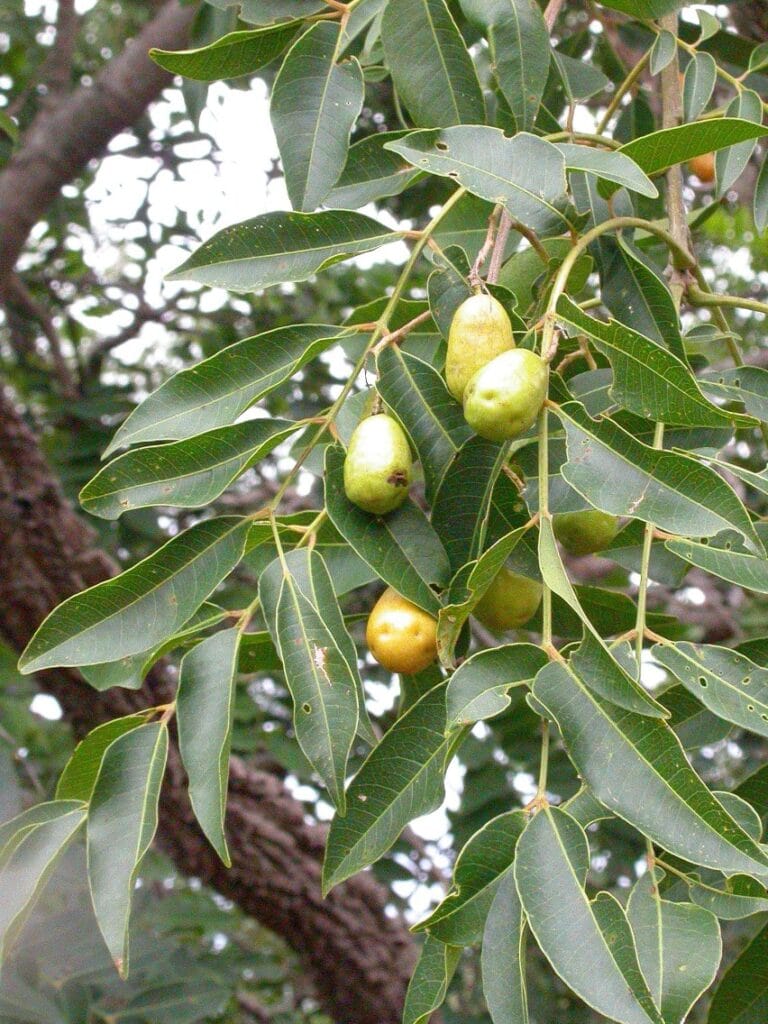Taperiba:
What is it?, History, cultivation, nutritional value, uses, recipes, and more...
Taperiba (Spondias dulcis) is a fruit that grows in tropical areas and is used by its inhabitants as an edible and nutritious fruit. In Peru, it is mainly found in the Amazon region and does not have the industrialization and popularity that its organoleptic and nutritional properties deserve.
Índice
What is Taperiba?
Taperiba, also known as ambarella or yellow mombin, is a medium to large-sized tree that typically reaches a height of 5 to 25 meters and a width of 60 cm. It has a rounded crown with horizontal or ascending branches. The outer bark is cracked, brown or gray, often rough with longitudinal ridges, and the inner bark is pinkish-orange with whitish longitudinal veins. Its leaves measure between 18 and 43 cm in length and have narrowly oblong leaflets, sometimes narrowly ovate, lanceolate, or elliptical. The edible part of this plant, the fruit, is oblong or, less frequently, ellipsoid or slightly ovoid, measuring 2-4 cm in length and is yellow or orange when ripe.
For its proper development, Taperiba requires a warm and rainy climate. It adapts to all types of soils except for flooded ones, as long as it has good luminosity and temperatures above 12°C. Its fruits are harvested at 4 years, and the maximum production is reached at 7 years after planting.
History of Taperiba
Ortega (1974) and Calzada (1980) mentioned by Sáenz (2005) report that the ambarella or Taperiba (Spondias cytherea soon) is synonymous with Spondias dulcis Forsty and Spondias dulcis Parkinson. This fruit can be found up to 700 meters above sea level in the tropics, and its origin is found in the Society Islands of the South Pacific (Oceania), possibly reaching Jamaica between 1782 and 1792. From there, it would spread throughout America. This fruit grows and thrives in almost all tropical countries and is better known in the northern region of our country as “ambarella” and in the jungle as “Taperiba”; it is a close relative of the mango.
It is said that it was previously called “sour plum” in Peru, and it was a Brazilian who reported the fruit during the colonial period and called the tree “Titiribá” in Tocantins.
This fruit is quite common in India and Ceylon. It is sold in markets in Vietnam and other places in former Indochina. It is cultivated in Queensland, Australia, and has grown on a small scale in Gabon and Zanzibar.
Habitat of Taperiba
The species was introduced from Oceania (Mitchell & Daly, 1998). Taperiba is observed in areas with high and constant rainfall, as well as in areas with marked dry seasons. It grows in soils with varying texture and acidity, as long as they have good fertility and good drainage.
Taperiba (Spondias dulcis Sol. ex Parkinson) is found throughout Asia, Australia, Central and South America, the Caribbean, and parts of Africa (Bartoo and Badrie 2005, Lira et al. 2014). It is also known regionally as “tapisho” and is abundant in the Peruvian Amazon (Brako and Zarucchi 1993).
The ambarella is widely distributed in the Iquitos and Pucallpa areas (Department of Loreto), Chanchamayo and Satipo (Department of Junín), Chulucanas and Sullana (Department of Piura), as well as in the departments of San Martín, Huánuco, and Ucayali. This fruit adapts to the Lower Jungle of the Loreto department, as it is an area of tropical rainforests and tropical dry forests. It can also adapt to warm and humid tropics, where it thrives best in moist, dry, and soft soils. In the Piura Region, the ambarella is distributed in the Marcavelica and Querecotillo areas, province of Sullana, department of Piura. Likewise, it can be cultivated in the warmer areas of the subtropics and dry tropics of the region.

Common Names of Taperiba
| El Salvador | Jobo, jocote, jocote de corroncha o de pava |
| Brasil | Caja-mango, Cajarana, Cajaseira de Fruto Grande, Taperiba-Assu |
| Perú | Ubos, mango ciruelo |
| Colombia | Ciruela, jobo |
| Bolivia | Cedrillo |
| Venezuela | Ciruela joba, jobito |
| República Dominicana | Jobo |
| Cuba | Ciruelo, cirolero agrio o amarillo, Jobo de la India |
| Área caribeña | Yellow mombin, hog plum |
| Jamaica | Spanish plum, gully plum |
| Costa Rica | Yuplón |
| México | Ciruela, jobo, jobito |
| Nigeria | Iyeye |
| Ghana | Hog plum, Ashanti plum |
| Inglaterra | Otahite Apple |
| Polinesia | Ambarella |
| Tahití | Menbrillo Tahitiano, Ciruelo Gigante, Manzana de Tahiti |
| Ceylan | Ambarella |
| India | Bilati-amra |
| Francia | Arbre de Cytherea |
| Taperiba | Perú |
Scientific Name of Taperiba
Spondias dulcis
Taxonomy of Taperiba
| Reino | Plantae |
| División | Magnoliophyta |
| Clase | Eudicotyledoneae |
| Subclase | Rosidae |
| Orden | Sapindales |
| Familia | Anacardiaceas |
| Subfamilia | |
| Tribu | Chenopodieae |
| Género | Spondias |
| Especie | Spondias dulcis |
Synonymy of Taperiba
Mauria juglandifolia Benth. ex Engl.
Spondias aurantiaca Schumach. & Thonn.
Spondias axillaris Roxb.
Spondias cythera Tussac
Spondias dubia A. Rich.
Spondias graveolens Macfad.
Spondias lucida Salisb.
Spondias lutea L.
Spondias lutea Royen ex Blume
Spondias lutea var. glabra Engl.
Spondias lutea var. maxima Engl.
Spondias oghigee G. Don
Spondias pseudomyrobalanus Tussac
Etymology of Taperiba
In Peru, Taperiba is also known as “ambarella” because its texture resembles mango and its taste is sweet and sour like a plum.
Geographical Distribution of Taperiba

Loreto, Junín, San Martín, Huánuco, Piura
Seasonal Availability of Taperiba
- In Peru, the fruit ripens between July, August, September, October, November, December, and January.
Nutritional Value of Taperiba
Ambarella is a fruit rich in acids and vitamin C, a highly recommended vitamin as it strengthens the immune system, protecting us from many diseases. It also contains high levels of calcium and phosphorus, and to a lesser extent, iron.
Taperiba is not only rich in nutrients but also has a high content of phytochemicals, also known as bioactive compounds, such as ascorbic acid, phenolic compounds, flavonoids, carotenoids, tannins, etc., which help prevent the development of various types of cancer and cerebrovascular and cardiovascular diseases, including Alzheimer’s disease.
In a study by Oriondo et al. (2016), the antioxidant capacity of different Amazonian fruits from Peru was evaluated against lemon juice, and it was determined that Taperiba juice showed a higher percentage of antioxidant activity (353%) compared to other fruits such as cashew (107%), caja fruit (201%), arazá (268%), and caimito (302%). Furthermore, the antioxidant capacity of all the Amazonian fruits studied exceeded that of lemon fruit (100%).
Silva et al. (2018) evaluated the antioxidant potential of aqueous extract of Taperiba and reported average values of 57.66 mg GAE g -1 of total phenolic compounds, higher than the values found for guava (10.81 mg GAE g -1).
Tiburski et al. (2011) reported the content of total phenolic compounds, antioxidant activity, and characterized the carotenoids of frozen Taperiba fruit pulp. They found average values of 17.5 mmol of TEAC g -1 of antioxidant activity, superior to other typical fruits from northeastern Brazil such as umbu (1.07 mmol TEAC / g), soursop (6.09 mmol TEAC / g), sapodilla (0.99 mmol TEAC / g), papaya (7.6 mmol TEAC / g), and pineapple (3.78 mmol TEAC / g); 260 mg of gallic acid / 100 g of total phenolic compounds, higher than the values found in acai (136.8 mg GAE / 100 g), guava (83.1 mg GAE / 100 g), strawberry (132.1 mg GAE / 100 g), pineapple (21.7 mg GAE / 100 g), soursop (84.3 mg GAE / 100 g), and passion fruit (20.2 mg GAE / 100 g). They also indicated that 100 g of pulp can provide more than 37% of the recommended daily amount of vitamin A.
Health Benefits of Taperiba
Taperiba or ambarella is rich in vitamin C, vitamin A, calcium, iron, bioactive compounds, and other beneficial compounds that promote overall health.
Contraindications or Side Effects
There are no significant contraindications, but it is worth noting that the bark of the tree can cause temporary vomiting and may have abortive effects.
| 10 Porciones por Kilogramo | |
| Tamaño de porción | 100g |
| Cantidad por porción Calorías |
56 |
| Cantidad por 100g | |
| Energía | 234 kJ |
| Grasa Total | 0.3 g |
| Sodio | ● |
| Carbohidratos totales | 14.2 g |
| Carbohidratos disponibles | ● |
| Fibra Dietaria | ● |
| Proteínas | 0.6 g |
| Calcio | 39 mg |
| Fósforo | 27 mg |
| Zinc | ● |
| Hierro | 0.70 mg |
| Potasio | ● |
| Agua | 84.5 g |
| Cenizas | 0.4 g |
| Vitamina A | 0 μg |
| Tiamina (B1) | 0.05 mg |
| Riboflavina (B2) | 0.19 mg |
| Niacina (B3) | 0.67 mg |
| Vitamina C | 5.90 mg |
| Acido Fólico (B9) | ● |
| β-Caroteno | ● |
| Fuente: Tablas peruanas de composición de alimentos – Centro Nacional de Alimentación y Nutrición – Ministerio de Salud – Perú | |
Derived Products and Forms of Consumption of Taperiba
Uses of Taperiba
In addition to direct consumption, Taperiba or ambarella can be used in various ways both within and outside the culinary sector. It is an important source of nutrients, and all parts of the plant can be utilized for human benefit.
- Culinary
- Medicinal
- Industrial
Culinary Uses of Taperiba
The fruit of Taperiba is eaten directly like any other fruit. The fruit juice is used to make ice creams, jams, and beverages, as well as Taperiba wine, which has diuretic properties and is recommended for relieving cystitis.
In the Eastern Plains of Colombia, consuming the fruits as food is very common both among humans and the local fauna. During the summer season, the fruits are consumed by livestock.
It is said that during colonial times (17th century), Spanish conquistadors quenched their thirst by drinking the sap from the roots of this tree while on expeditions. In addition, the extinct Muisca indigenous people of Cundinamarca, Colombia, prepared a decoction of its leaves and shoots to relieve inflammation in the body.
In Costa Rica, when the fruit is unripe, it is divided into portions and eaten with salt; on the other hand, when it is ripe, only the peel is removed and it is bitten into until reaching the seed. Likewise, its ripe pulp is used in the preparation of juices, liqueurs or cocktails, ice creams, preserves, jams, sauces for meat accompaniments, and dressings.
In Peru, the fruit pulp is used to prepare:
Taperiba ice creams.
Refreshing Taperiba beverages.
Taperiba jams.
Taperiba yogurt.
Fermented Taperiba drink.
Medicinal Uses of Taperiba
As a medicinal use, it is known that in the Orinoco regions, baths are made from the boiled bark of Taperiba to heal wounds. This custom dates back to ancient times, as there is data reporting that in 1579, the indigenous people of the province of Maracaibo cured sores and wounds with the infusion of the leaves. The Tikuna indigenous people of the Amazon region in Colombia also used the infusion of the leaves and bark to alleviate the pains of childbirth, as baths for wound healing, took a cup a day during menstruation as a contraceptive, and used the infusion of the bark to soothe tired feet. An interesting belief of this culture stated that if a Tikuna woman took an infusion of Taperiba bark the day after giving birth, she would become infertile.
In Colombia, the boiled bark is also attributed with healing, hemostatic, and astringent properties. The infusion is currently used in the treatment of wounds, diarrhea, intestinal ulcers, amenorrhea, and vaginal infections. They extract a resin from the bark and apply it directly to skin wounds. If the bark is already dry, they grind it into a fine powder and apply it to wounds after washing them. The maceration of the leaves is also used to treat rashes by applying it directly to the affected area, and the extracts of the leaves and bark can cause temporary vomiting, which has abortive properties. Direct application of Taperiba fruits is also recorded for skin inflammations and combating gum infections, and consuming the fruit directly prevents intestinal and bladder diseases. Additionally, the infusion of the roots and leaves is used to reduce fever, treat colds, and cleanse wounds.
In Peru, Taperiba is used in natural medicine for cases of indigestion, vomiting, and colic by making a decoction of the bark, which has emetic and astringent properties. Furthermore, leaf extract is used for its antimicrobial function, as well as for its relaxing effect on smooth muscles, uterine stimulation, antiviral activity, and anti-fertility properties. The bark of its roots is used as an anti-diarrheal and calming agent.
Industrial Uses of Taperiba
Taperiba is employed in the timber industry for its characteristics: its trunk is excellent for planing, fair for turning, drilling, and notching, moderately good for sanding, and good for resistance to screw splitting.
It is used for the production of:
Veneers. Packaging boxes. Wood for making matches. Paper.
It is also used to make charcoal and as a substitute for cork. It is useful in erosion control, soil conservation, as a windbreak, and for ornamental purposes.
In addition, its fruits are highly valued as fodder for livestock.



